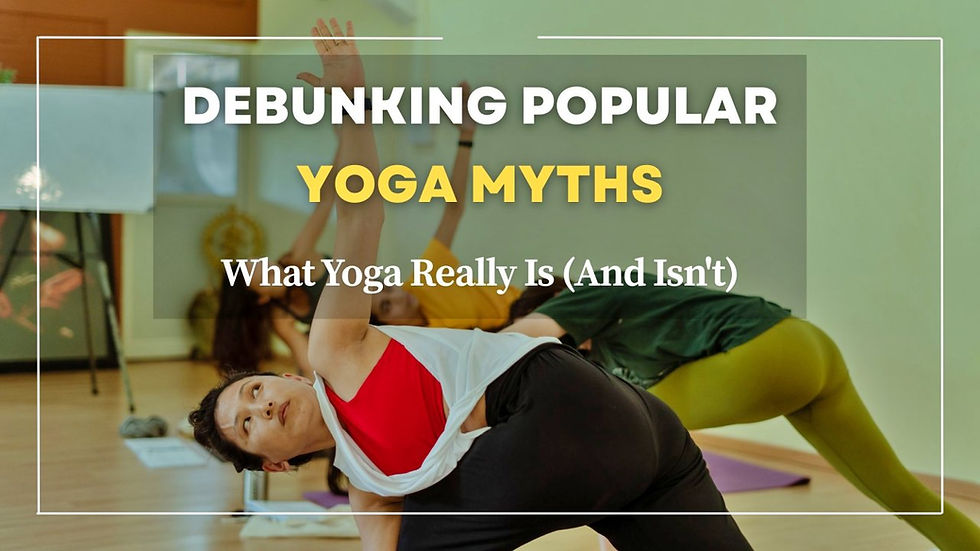Debunking Popular Yoga Myths: What Yoga Really Is (And Isn't)
- Yogacharya Rakesh

- Sep 19, 2022
- 3 min read
Updated: Jul 13
Let’s face it — Yoga is misunderstood.
From Instagram scrolls to locker-room chats, the myths around Yoga are everywhere — and surprisingly, they aren’t just believed by beginners. Even seasoned practitioners sometimes carry subtle misconceptions that limit their experience on the mat.
So, if you're new to Yoga (or even if you’ve been practicing for years), this article is your reality check.
Let’s debunk some of the most popular myths about Yoga — and if you’re a Yoga teacher, these are exactly the kinds of conversations you’ll want to have with your students to help them start their journey without judgment or fear.

Myth 1: You Have to Be Flexible to Do Yoga
Ah yes, the classic one.
We’ve all heard (or said) it at some point:“I want to try Yoga, but I’m not flexible.”
Let’s be clear — you don’t do Yoga because you’re flexible. You become flexible because you do Yoga.
Yoga is over 2000 years old and much more than stretching or contorting the body. Asana (the physical postures) is just one part of the eightfold path. You don’t need to touch your toes, balance on one hand, or look like anyone else on social media.
Your flexibility is not a requirement — it's an outcome. What you really need is willingness and consistency.
Yoga meets you exactly where you are, not where someone else is. So don’t let your tight hamstrings stop you from stepping onto the mat. That’s where the real transformation begins — both physically and mentally.
Myth 2: Yoga Is Just a Workout
Yes, Yoga can be physically intense. But to call it just a workout is like calling the ocean a swimming pool.
Yoga isn’t just about sweating, stretching, or getting toned. It’s a spiritual practice that includes breathwork (Pranayama), meditation (Dhyana), inner inquiry (Svadhyaya), and ethical living (Yamas and Niyamas).
If you're only chasing weight loss or a six-pack, Yoga might give you that as a by-product. But more importantly, it will teach you how to sit with yourself, how to breathe through life, and how to move inward.
As we often say —
Yoga is not a workout. It’s a work-in.
Myth 3: Yoga Will Instantly Make You Happy and Calm
We wish it were that simple.
Yes, Yoga brings peace — but that peace is often found through discomfort. The practice doesn’t always feel like floating in bliss. Some days, it feels like sitting in emotional mud — confronting anxiety, restlessness, or even sadness.
And that’s okay. That’s Yoga too.
The truth is, the practice can stir things up before it settles them down. Over time, with commitment, what unfolds is a quiet kind of strength, clarity, and calm that isn’t dependent on mood or circumstance.
Don’t give up because the first few sessions don’t feel magical. Stay with it. The practice works — just not always in the way you expect.
Myth 4: Mastering Advanced Asanas Makes You Better at Yoga
Let’s talk about the handstands and pretzel poses we see all over Instagram.
While they look impressive, they’re not the goal of Yoga. They’re just one small expression of it.
Yoga is not a competition, and advanced asanas aren’t a sign of spiritual superiority. Your ability to stand on your head means little if you can’t sit with your own mind.
Some days, your practice may look like a strong flow. Other days, it may be 10 minutes of conscious breathing. And sometimes, true Yoga is choosing rest when your body asks for it.
What matters most is awareness, intention, and surrender. That’s where the real depth lies.
In Summary: What Yoga Truly Offers
The Yoga world — especially online — is filled with misinformation, aesthetic ideals, and performance-based expectations. But at its heart, Yoga remains a deeply personal, transformative, and inclusive path.
If you're a teacher, help your students move past these myths.If you're a student, let go of judgment and allow yourself to begin — exactly as you are.
Because Yoga isn’t about perfection. It’s about presence.
Ready to start or restart your journey?
Take a breath. Unroll your mat.Let Yoga meet you where you are — not where you think you should be.




Comments